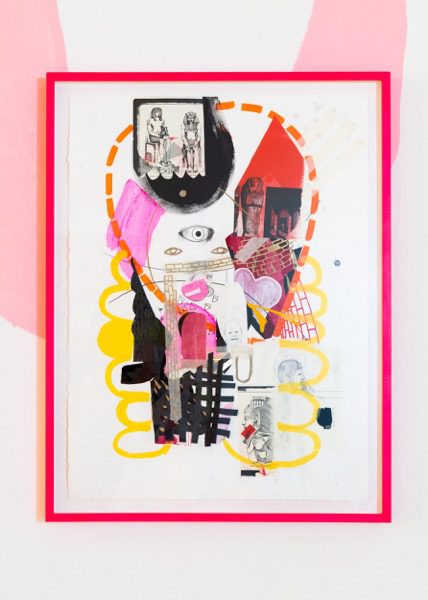
Acrylic, flashe, marker and paper collage on paper.
Courtesy of the artist.
In the feature, “Oppositional Responses: Jackie Milad’s Mixed-Media Narratives,” published in BMoreArt Journal of Art + Ideas, art historian Jordan Amirkhani explores the innovative techniques and visual effects in Jackie Milad‘s mixed media work.
Focusing on Milad’s solo exhibition at Julio Fine Arts Gallery at Loyola University Maryland in February 2020, titled It Means Desert, Desert, Amirkhani delves into the complex network of references to visual culture and language underlying Milad’s assemblages.
De Buck Gallery is pleased to spotlight Jackie Milad this month, in an online virtual exhibition and interactive VR Experience of a fresh body of work reflecting a breakthrough moment in Milad’s practice. These works were created exclusively for De Buck Gallery during Milad’s recent residency at the McColl Center in Charlotte, North Carolina.
Read excerpts from the feature below:
“Bold, symphonic constellations of colors, symbols, and historical strategies—from collage and archival methods to handicrafts and graffiti—form a palimpsest of oppositional responses available to artists critical of the medium- and genre-specific silos that so often frame contemporary art.
Through a rich accumulation of visual, textual, and symbolic content, Milad invites us to struggle with the act of making meaning as well as our desire to know, understand, translate, and thus take ownership of her pieces and their many disparate elements.
This is most evident in Milad’s use of shiny, sparkling materials and textures that refract light, not to grant illumination to the viewer as the history of these materials in the Western tradition are often prescribed to do, but to obfuscate and conceal complete access to the image and its meanings instead. By holding visual wholeness (and therefore comprehensive narrative) at bay, Milad’s works present a rejection of the various demands placed on artists and artworks to unfurl themselves as totally coherent and available to the observer-interpreter.
The works in the exhibition, titled It Means Desert, Desert—nodding to a joke between Milad and her father about the absurd repetition in the English translation of “Sahara Desert”—are piled thick with humorous quips, private references, and linguistic codes culled from various languages and visual cultures that thrust clarity and legibility back into the viewer’s face.
Not only are Milad’s techniques of assembling these visual barricades acts of authorial agency where she freely explores her own experiences as an Egyptian-Honduran first-generation American, her paintings point to the possibility of greater understanding to those initiated few who can crack the codes and reward those who find new narratives in them.
While Milad is deeply invested in holding meaning in suspension, this does not imply that her art is devoid of shared affinities or community—quite the opposite, in fact. There are many treasures to find and luxuriate upon in these works, which are often made from an archive of past drawings and paintings, an exciting act of transgressive self-appropriation resistant to the tradition of rendering prior works precious and forgotten.”
“Perhaps a better way to unpack Milad’s cryptic and deeply personal archive of gathered fragments is to be reminded that the incorporation of symbols is not always an invitation for viewers to decode, but rather to exist in a more uncomfortable state of suspended misunderstanding. While Milad offers clues, she also resists exposing an exact translation, choosing to keep the full interpretation to herself. Holding onto a painting’s secrets for a select few is not a recapitulation of the elitist inaccessibility that runs rampant in the artworld, however. It can instead be a form of refusal to institutional conditions that demand total disclosure from artists who are relegated to the margins of society and culture.
In a discourse dependent on looking and perceiving to create value and meaning, Milad’s mixed-media process refuses to reveal itself completely, catalyzing a new ecology of relationships between the artist, the viewer, and the piece itself.
By denying the traditional order for artists (women artists and artists of color in particular) to essentially “undress” and perform for the expectations shaped by predominantly white viewers and institutions, Milad’s art instead asks the audience to sit with their lack of knowledge, make space for their incomplete understanding, and resist the temptation to wholly identify with the work and/or artist when it is inappropriate for them to do so. In this way, the onus of learning is relocated to those who stand in front of Milad’s artworks and the institutions that present them, suggesting it is time for marginalized artists to do less, and institutions and viewers to do more.”
To read the full interview, “Oppositional Responses: Jackie Milad’s Mixed-Media Narratives,” please click the link below.

